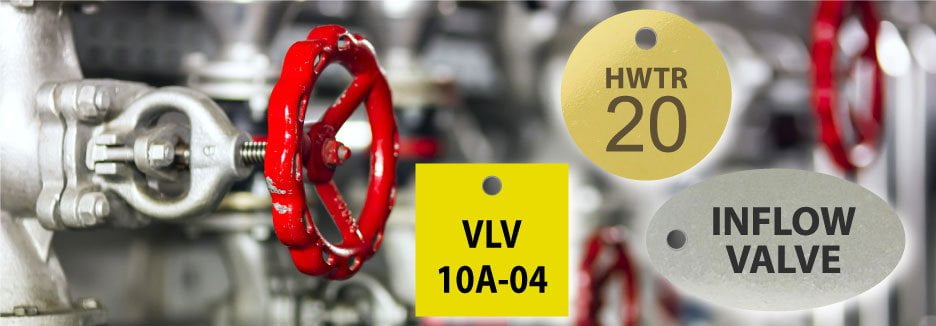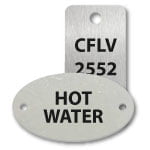
Inland Products offers:
- Valve Tags in a choice of Brass, Aluminum, Stainless Steel or Plastic
- Logos, Text and Numbering when Ordering Engraved
- Several Color Choices in Aluminum or Plastic
- Metal Valve Tags provide Maximum Durability
- Plastic and Aluminum Valve Tags for Color Coding
Valve Tags in Aluminum, Brass, Stainless Steel or Plastic
We’re a manufacturer and engraver of valve tags in anodized aluminum, brass, stainless steel or plastic. Offering you in-stock sizes, as well as custom sizes and shapes created to your specifications. We’re committed to providing quality valve tags, to fit your needs.
In-Stock Valve Tags
Inland Products manufactures a line of stock blank tags for your engraving needs. These sizes and shapes are the most commonly required by our customers. We create these stock tags using modern high-speed presses to obtain maximum efficiency. This efficiency allows us to compete even with overseas suppliers. So, you can rely on us for quality and affordability.
We can engrave these stock tags for you as well, should you require a personalized finished product. We’re also able to custom engrave barcodes and QR codes on them for you, making them even more useful.
Custom Valve Tags – Blank or Engraved
If you’re looking for completely custom valve tags from your specifications, you’ve come to the right company. Inland Products maintains it’s own tool and die shop staffed with highly skilled tool and die makers that can handle any custom metal tags requests we get from our customers.
We take pride in working with our customers to find the valve tags that are best suited for their specific needs and application. We’re happy to provide design assistance at no additional charge to you when you’re not sure of the layout you want.
Valve Tags are Essential to Pipe Identification
An effective marking strategy for pipes goes above and beyond merely labeling the pipes. It also includes using tags. One of the most overlooked efficiencies and safety aspects of the facility is using identification markers like these. This is because many people believe valves and pipes are a simple system, running in the background, not requiring much thought. However, systems inappropriately labeled, serve as a dangerous safety hazard.
Learning to use tagging properly may be of interest to your facility. Or, you may be looking to improve how your facility is using this type of identification. Either way, you’ll benefit by understanding why these are essential to pipe identification.

What Are Valve Tags?
Valve tags are a type of identification marker used to specify the function and content of a pipe that a valve operates. These markers can be made of Brass, Anodized Aluminum, Stainless Steel or Plastic. But, choosing the material for your marker depends on the unique needs of your facility.
Your means of identification could range in size from a small round, big enough to hold a few numbers, up to a large square that holds more detailed essential information. Whatever your particular requirement, these identifiers are an important part of your safety protocol which should aim to reduce risks of accidents, spills, and injuries caused by improper use of the valves within your facility.
Valve Tag Regulations
The most important reason for using this type of identification is to keep your employees safe. However, there are some situations where OSHA and ANSI have guidelines requiring facilities to use specific means of marking. Make sure you’re aware of all of the current OSHA and ANSI regulations to keep your company updated on the latest safety requirements.
Click here for more information about PIPING IDENTIFICATION AND VALVE TAGGING STANDARD.
The Importance of Valve Tags
Using this type of marking provides your maintenance staff and operators with crucial information about that valve system and the piping that goes around it. This helps to maintain the safe operation of your facility, as well as the safety of your staff.
By adequately marking the components, you’re providing employees with a visual tool helping reduce risks of accidents, workplace injuries, and spills caused by the improper use or care of the system.
For example, using colored tags identifies types of materials contained in pipes. A red marker commonly designates the presence of hot liquid within pipes, while a black and yellow striped marker identifies pipes and components containing a hazardous substance.
Before applying tags to your pipes, you should audit your facility. This means you’ll need to take a walk around your plant and identify all the components needing to be tagged. As for doing this, you can assign numbers to the components that need to be labeled, placing them into a tag chart or on a digital table.
By auditing your system and identifying information you want on your valve tags, and by placing this in a log for staff access, you’ll provide a tool your maintenance staff can use when they’re asked to assist in emergencies.
We’re Here To Help!
Inland Products has an experienced, knowledgeable, and helpful sales staff waiting to answer any questions you may have. We are here to help you make the best choices for your valve tags!
Please call us at 1-800-481-5500 or email sales@inlandproducts.com















